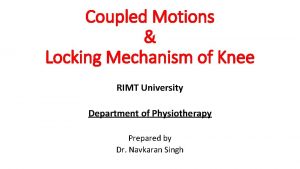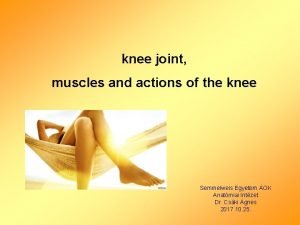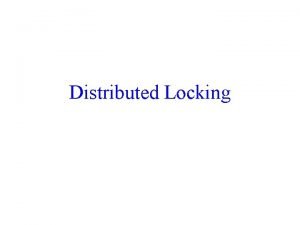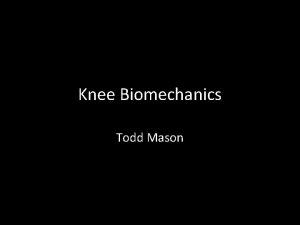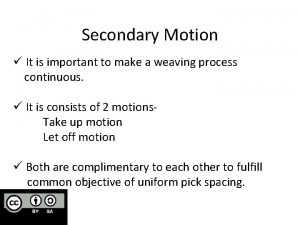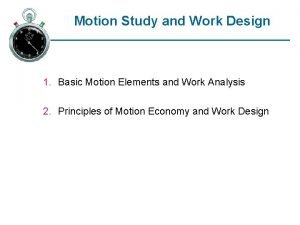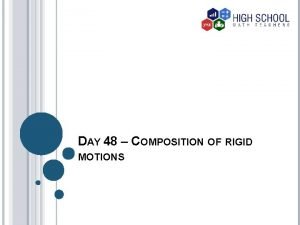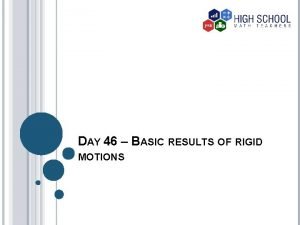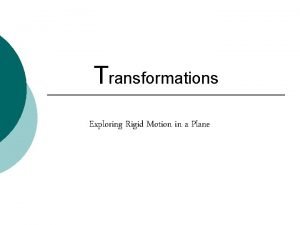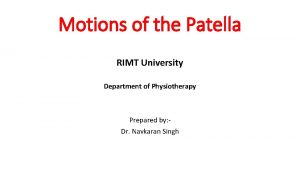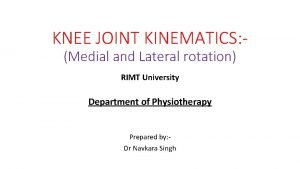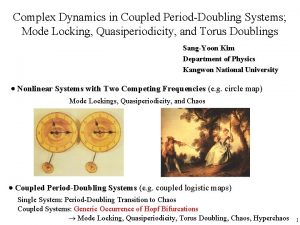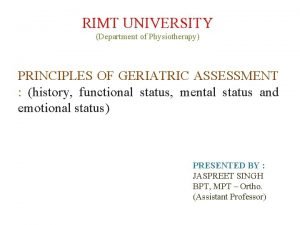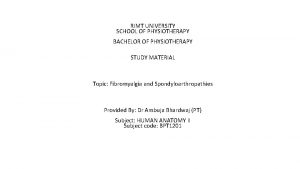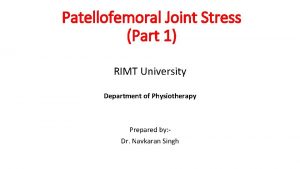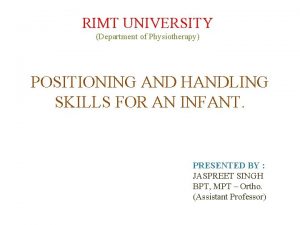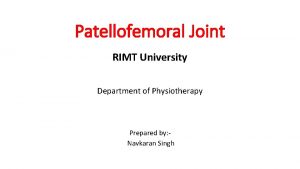Coupled Motions Locking Mechanism of Knee RIMT University














- Slides: 14

Coupled Motions & Locking Mechanism of Knee RIMT University Department of Physiotherapy Prepared by Dr. Navkaran Singh

COUPLED MOTIONS 1. Tibiofemoral motions are not straightforward (individual Flexion/extension or individual Medial rotation/lateral rotation or individual varus/valgus motions) 2. Biplanar intraarticular motions occur because of the oblique orientation of the axis of motion with respect to the bony levers. 3. The true flexion/extension axis is not perpendicular to the shafts of the femur and tibia. (fig A)


• Therefore, flexion and extension do not occur as pure sagittal plane motions but include frontal plane components termed “coupled motions”. • The medial femoral condyle lies slightly distal to the lateral femoral condyle, which results in a physiologic valgus angle in the extended knee that is similar to the physiologic valgus angle that exists at the elbow.


• With knee flexion around the obliquely oriented axis, the tibia moves from a position oriented slightly lateral to the femur to a position slightly medial to the femur in full flexion; that is, the foot approaches the midline of the body with knee flexion just as the hand approaches the mid- line of the body with elbow flexion. Flexion = coupled to a Varus motion Extension = coupled with Valgus motion

AUTOMATIC/LOCKING MECHANISM OF KNEE • It is the terminal stage of the knee extension of the knee joint • There is an obligatory lateral rotation of the tibia that accompanies the final stages of knee extension that is not voluntary or produced by muscular forces. • This coupled motion (lateral rotation with extension) is referred to as automatic or terminal rotation.

• The medial articular surface of the knee is longer (has more articular surface) than the lateral articular surface • So, during the last 30 degree of knee extension (30 to 0 degree), the shorter lateral tibial plateau/femoral condyle pair completes its rolling-gliding motion before the longer medial articular surfaces do. • As extension continues (referencing non–weight-bearing motion of the tibia), the longer medial plateau continues to roll and to glide anteriorly after the lateral side of the plateau has halted.

• This continued anterior motion of the medial tibial condyle results in lateral rotation of the tibia on the femur, with the motion most evident in the final 5 degree of extension. • Increasing tension in the knee joint ligaments as the knee approaches full extension may also contribute to the obligatory rotational motion, bringing the knee joint into its close-packed or locked position. • The tibial tubercles become lodged in the intercondylar notch, the menisci are tightly interposed between the tibial and femoral condyles, and the ligaments are taut.

This automatic rotation is also known as the locking or screw home mechanism of the knee.

INITIATION OF FLEXION/ UNLOCKING OF KNEE • To initiate knee flexion from full extension, the knee must first be unlocked; that is, the laterally rotated tibia cannot simply flex but must medially rotate concomitantly as flexion is initiated. • A flexion force will automatically result in medial rotation of the tibia because the longer medial side will move before the shorter lateral compartment. • If there is a lateral restraint to unlocking or derotation of the femur, the joint surfaces, ligaments, and menisci can become damaged as the tibia or femur is forced into flexion.

• This automatic rotation or locking of the knee occurs in both weight-bearing and non–weight-bearing knee joint function. • In weight-bearing, the freely moving femur medially rotates on the relatively fixed tibia during the last 30 degree of extension. Unlocking, consequently, is brought about by lateral rotation of the femur on the tibia before flexion can proceed.

• The motions of the knee joint, exclusive of automatic rotation, are produced to a great extent by the muscles that cross the joint.

Thank you
 Knee locking mechanism
Knee locking mechanism Art genus
Art genus Locking and unlocking of knee joint
Locking and unlocking of knee joint Knee screw home mechanism
Knee screw home mechanism Primary motions of weaving
Primary motions of weaving The principle of motion economy was developed by:
The principle of motion economy was developed by: Composition of transformations: rigid motions (discovery)
Composition of transformations: rigid motions (discovery) Song leading
Song leading Ocean motions
Ocean motions Mun flow of debate
Mun flow of debate Basic rigid motions
Basic rigid motions Size separation objective
Size separation objective Which transformations map the strip pattern onto itself
Which transformations map the strip pattern onto itself True motions
True motions Meiosis flipbook
Meiosis flipbook
